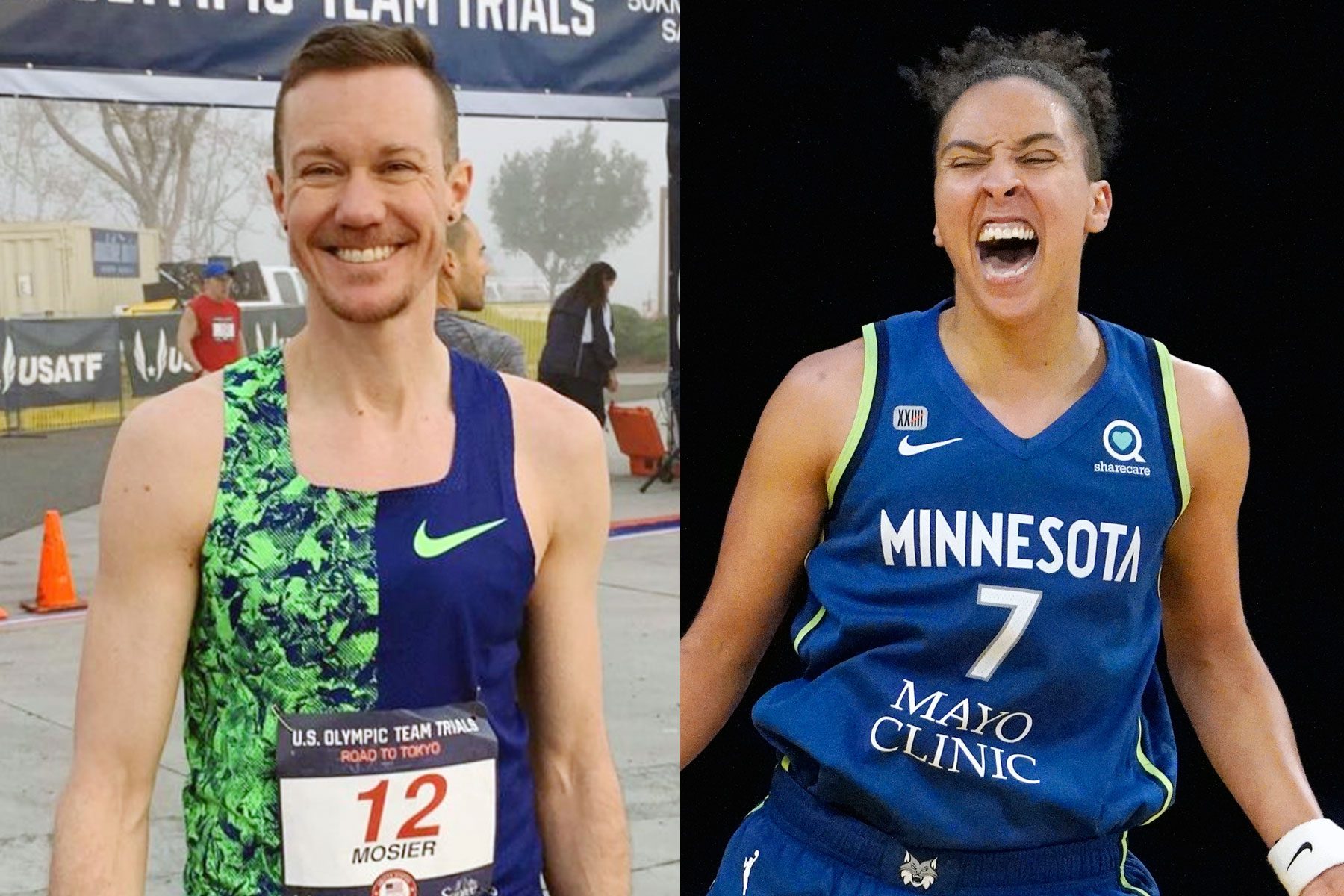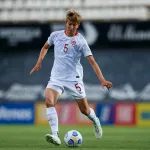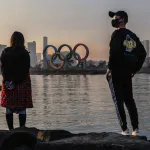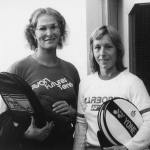It’s a record year at the Olympics for transgender athletes: New Zealand weightlifter Laurel Hubbard and Canadian soccer player Quinn have entered the competition, and BMX freestyle rider Chelsea Wolfe joins Team USA as an alternate.
How the world perceives them will depend on how news outlets portray them.
And reporters are rarely prepared to respectfully cover transgender players, two American trans athletes told The 19th.
Chris Mosier, the first trans athlete to qualify for the Olympic Trials in the gender they identify, said the media overshadowed other challenges he faced after coming out.
“I think even more than policies and more than fighting for space and having to tell people what I needed … my biggest struggle has always been with the media,” said Mosier, who has competed at the Olympic level in duathlon and triathlon events.
Mosier, who came out in 2010, spoke of “having to be cautious of who I talk to and how I speak with them, and considering very carefully what I share, because I know that every headline, every article that came out about me, at least in the first many years, was about my transness.”
Layshia Clarendon, the WNBA’s first openly nonbinary and transgender player, told The 19th that reporters not being equipped to thoroughly cover trans people stems from a broader lack of knowledge.
“I think there’s definitely a lack of general preparedness because that’s the world we live in, a very binary world,” she said. Clarendon uses she/her, they/them, and he/him pronouns interchangeably.
He added that news coverage of him since he came out as trans in late 2020 has been “phenomenal,” describing reporters who make the effort to use all of his pronouns and are still willing to make and learn from mistakes. Clarendon publicly identified as non-cisgender in 2015.
“The really hard part for me has been how reduced I feel to being just trans and non-binary now, too. I’m still Black, I’m still queer,” they said. “But because I’ve been the first … so much attention has been focused solely on my gender identity, it’s felt really reduced to that.”
Over time, Mosier said, he learned to take a different perspective on unbalanced news reports that paid more attention to his gender than his sport. “I came to accept it and see it as a gift,” he said, especially since he “made a commitment very early on to being public.”
Quoting trans people in articles about trans people is key to improving coverage, he said, as well as using current names and pronouns. Doing research ahead of time to get pronouns right, expanding stories to talk about more of the unique victories and challenges that trans athletes face, and not just reducing LGBTQ+ athletes to their gender identity or sexual orientation are also crucial, Clarendon said.
I don’t think we’re really comfortable with trans people winning in sports.
Layshia Clarendon, the WNBA’s first openly nonbinary and transgender player
The trans athletes in Tokyo for the Olympics are among the 163 out LGBTQ+ athletes competing in the 2021 competition as they did in 2016, per Outsport. This year, sports journalists, especially those covering the Games, have more resources to cover LGBTQ+ athletes than they did during the 2016 games.
The Transgender Journalists Association, founded last February, has a style guide for reporters covering trans people and related issues. The Associated Press formally found using “they/them” pronouns acceptable in 2017 and explained its reasoning for limited use as a gender-neutral and singular pronoun.
GLAAD’s guide for journalists covering LGBTQ+ athletes at the Tokyo Games calls for using a trans athlete’s correct pronouns and name — including in historical references — and to avoid asking questions about their genitalia or possible transition-related surgeries. The guide is GLAAD’s first since the 2014 games in Sochi, Russia, GLAAD spokesperson Mary Emily O’Hara told The 19th.
In 2016, poor coverage of LGBTQ+ Olympians included a now-deleted Daily Beast story detailing the dating profiles of primarily gay athletes — including at least one competitor from a country with strict anti-gay laws. The author later apologized for the story. Another gaffe included NBC announcer Chris Marlowe mistakenly referring to a Brazilian beach volleyball player’s wife as her “husband,” for which he apologized.
GLAAD’s guide to the games aims to benefit reporters as well as the world-class athletes they cover, as LGBTQ+ athletes hope for coverage that uplifts some of the most marginalized voices in the community.
Maya Satya Reddy, an LGBTQ+ athlete activist and Toll Public Interest Scholar at the University of Pennsylvania Law School who left professional golf in 2018, told The 19th that reporters should talk to more LGBTQ+ athletes who aren’t White and cisgender, and who aren’t competing at elite levels.
“It does feel like there is a lot of coverage that focuses on the tragedy of a marginalized athlete and their experience as opposed to having a celebratory outlook,” Reddy added.
Reddy said she left golf as a means of self-preservation, after she was frequently surrounded by golfers and tournament directors making disparaging comments about sexual orientation and race. While she was in the sport, she didn’t feel like there were any news outlets she could go to to talk about the environment that felt hostile to people like her — a queer, South Asian woman.
“I was really hurt feeling that I needed to take a step away for myself, to protect myself,” she said.
GLAAD’s guide also recounts that the first known gay Olympic athlete, John Curry, was outed by the press soon after winning gold at the 1976 games — pointing to a longer fraught history between LGBTQ+ athletes and the media.
Now LGBTQ+ athletes have been able to choose when they come out — and incidentally make history in the process.
Carl Nassib, the first active NFL player to come out as gay, said last month that although he hopes one day that coming out announcements aren’t necessary — that LGBTQ+ acceptance is more commonplace — being visible and representing the community is a priority for him.
Luke Prokop, the first active hockey player under a NHL contract to come out as gay this week, said in an Instagram post that he was “no longer scared to hide who I am.”
LGBTQ+ athletes know that breaking barriers doesn’t always guarantee true acceptance — especially for transgender competitors, who say they often face additional scrutiny when they win.
Some of that scrutiny has driven lawmakers’ motivations to bar trans girls from competing in school sports with other girls, citing unfair advantages that often aren’t seen in evidence within that state.
“We’re all celebrating the fact that there’s the first trans people there, but what if they go out and dominate the race?” Clarendon said. “I don’t think we’re really comfortable with trans people winning in sports.”
“I think that’s a big problem. We can’t just say that you can participate as long as you’re not good,” Mosier said in agreement.
The irony of seeing trans athletes competing at the highest level in the world for the first time, against a backdrop of legislation brought in the U.S. to ban trans youth from school sports that align with their gender identity, is not lost on Clarendon and Mosier.
“Visibility is not always a positive thing. Because with increased visibility comes increased targeting, increased violence, increased harassment, until there is a change in public opinion and public education,” Mosier said.
“It’s just so America,” Clarendon said. “The more visible you get doesn’t mean you’re necessarily safer and you’re better off.”
Editor’s note: Orion is a member of the Transgender Journalists Association.







